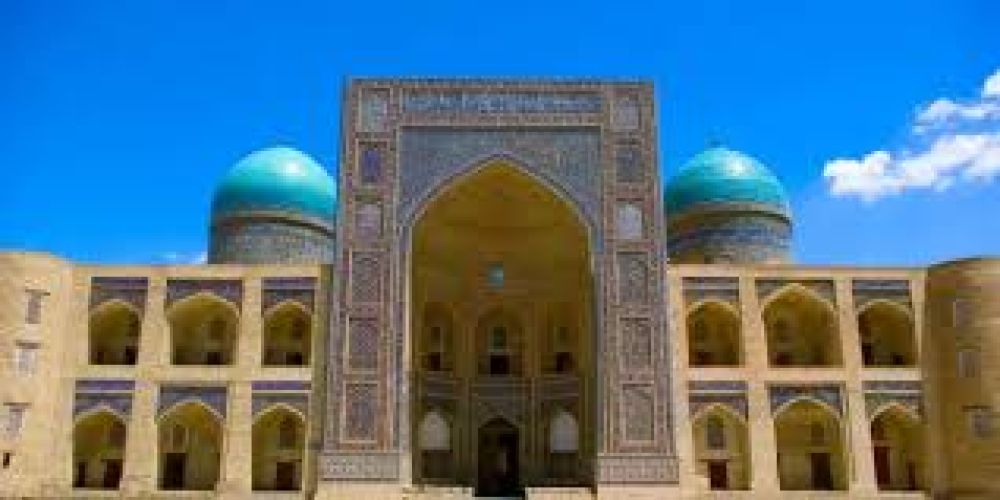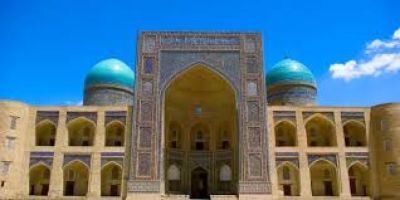

The Ark of Bukhara is a massive fortress located in the city of Bukhara, once the citadel of the emirs who ruled the region. The origins of the Ark date back to the 5th century AD, though it has been destroyed and rebuilt multiple times throughout its history. Today, it houses several museums that display artifacts and exhibits on the history of Bukhara and Uzbekistan. A visit to the Ark provides a deep dive into the ancient culture of the region, showcasing manuscripts, royal attire, weapons, and coins among its collections. The on-site museums also focus on the development of the Silk Road and the role that Bukhara played in regional trade. Exploring the Ark is like stepping back in time; you can walk through the royal quarters, see the throne room, and take in panoramic views of the city from atop its walls.
Lyab-i Hauz is a historic site in the heart of Bukhara, known for its tranquil and picturesque pond that dates back to the 17th century. This area is surrounded by magnificent architectural monuments, including the Nadir Divanbegi Madrasah, Khanaka, and the Kukeldash Madrasah. The pond itself was the center of civic life hundreds of years ago, providing water in a desert city. Today, it's a social hub where locals and tourists alike can relax at one of the many cafes and tea houses that line its banks. At night, the area comes alive with traditional music and dance performances giving visitors a glimpse of Uzbek culture. Strolling around Lyab-i Hauz is also an excellent opportunity to do some shopping, as there are numerous craft shops selling colorful textiles, ceramics, and souvenirs.
The Kalyan Minaret is one of the most iconic landmarks in Bukhara and a defining symbol of the city's skyline. At 48 meters tall, it has earned the nickname 'The Tower of Death' due to legends of criminals being executed by being thrown from the top. Constructed in 1127 AD, it is a marvel of medieval architecture and was once the tallest structure in Central Asia. Visitors can climb the narrow spiral staircase inside the minaret to reach a viewing platform on the top, offering breathtaking views of the city and surrounding region. The climb is somewhat arduous but the panorama is well worth the effort, promising a unique perspective on the city's historical buildings and busy bazaars.
For a truly local experience, Hammom Bozori Kord, a traditional bathhouse, dates back hundreds of years and offers a glimpse into the bathing culture of the region. This facility provides a comprehensive bathing service in an atmosphere that is rich with history and local customs. Visitors can indulge in a hot steam room, scrubbing, and a massage, perfect for those looking for relaxation and rejuvenation. Men and women have separate bathing times, so it is advisable to check the schedule in advance. Experiencing the hammam is not only about cleanliness; it's a social ritual and an excellent way to interact with locals and learn more about Uzbek customs and traditions.
Chor-Minor is a unique architectural gem of Bukhara that stands out because of its unusual design with four minarets, each adorned with distinctly different sky-blue domes. The name translates to 'Four Minarets', and this quirky structure was built in the 18th century and originally served as a gatehouse to a now-lost madrasah. Each of the four towers has different motifs and decorations, and they represent the diversity of the cultures and religions that have flourished in the region. Inside the Chor-Minor, you can find a quiet courtyard, a small mosque, and a little souvenir shop. The photogenic quality of the Chor-Minor makes it a must-visit for budding photographers as well as history enthusiasts.
The Nodir Devon Begi Madrasah is not only an educational institution but also a venue for folklore shows that invite visitors to enjoy the traditional dances and music of Uzbekistan. The building itself is an architectural marvel characterized by intricate tile work and grandiose design. Attending a show here in the evening provides a vivid display of national costumes, live music featuring regional instruments, and folkloric dance performances. This experience offers an enchanting and entertaining insight into Uzbek culture and heritage, making it a highlight for many visitors. Be sure to reserve your ticket in advance as these cultural evenings are quite popular and seating is limited.
Known for its ornate wooden columns and carved ceiling, the Bolo Hauz Mosque dates back to the early 18th century and serves as a prime example of classic Bukharan architecture. Built opposite the Ark fortress, it was the official place of worship for the Emir and contains a lovely reflective pool in its front plaza. The decorative elements of the mosque, with its painted aivans (terraces) and blue tiles, create an atmosphere that is both serene and magnificent. While Bolo Hauz Mosque remains an active place of worship, respectful visitors are welcome to explore and take in the detailed craftsmanship of this historical site. Women should remember to bring a headscarf to cover their hair before entering the mosque.
The Bukhara Silk Carpet Workshop is a fascinating place where visitors can observe the intricate process of handmaking silk carpets. This workshop showcases the traditional methods which have been passed down through generations and are still used to create these exquisite pieces of art. From the silkworms to the final weaving process, guests can witness the entire life cycle of the carpet production. Not only is it a chance to understand the artistry involved in the craft, but it also offers the opportunity to purchase one of these beautiful carpets as a treasured souvenir from Bukhara. The workshop is open to visitors and provides a personal look into the cultural heritage of rural Uzbekistan.
The Ismail Samani Mausoleum is a masterpiece of 10th-century Muslim architecture and one of Bukhara's oldest Islamic monuments. This architectural treasure has been recognized for its elegance, symmetry, and ingenious brickwork. Built as a resting place for the Samanid dynasty, the mausoleum has withstood the test of time thanks to its robust construction, even surviving the Mongol invasion that devastated much of Bukhara. Visitors stand in awe of the intricately detailed brick patterns that create a stunning three-dimensional effect on the exteriors. An excursion to this site is a journey not only through the history of the region but also through the evolution of Islamic mortuary architecture.
Bukhara's Jewish Quarter, or Mahalla, is a captivating area steeped in history and culture. With its narrow alleys and ancient homes, the Jewish Quarter reveals a different facet of the city's rich tapestry. For centuries, this neighborhood was the heart of the Jewish community in Central Asia and today, visitors can still see the Bukharian Jewish synagogues and schools. Exploring this district offers insights into the day-to-day lives of the people who have called this part of the city home for generations. Walking through the quarter, one can visit the local synagogue, engage with friendly locals, and maybe even sample some traditional Bukharian Jewish cuisine. This experience offers a valuable perspective on the diversity and multicultural heritage of Bukhara.
